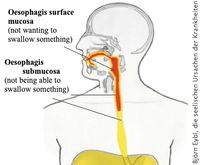Esophagus, upper 2/3
Also see: oesophagus, lower 1/3, oral and pharyngeal surface mucosa, oral submucosa, nasal and pharyngeal submucosa.
Sensitivity follows the gullet mucosa pattern.
Whether it involves the left or right side of the mouth or throat depends on biological laterality.
Theme
Not wanting to swallow something, wanting to spit something out. Something that you don't want has been or is being forced down your throat.
The lower 1/3 part of the esophagus is endodermal submucosa and deals with a morsel that you would like to swallow, but cannot or should not.
CA phase
Decrease in lining of esophagus, esophagus widens.
Biological utility
Being able to beter spit out something. when it becomes painful, it helps to prevent swallowing.
Symptoms
At first, none. The lining is quite thick and it takes some time before the sores are deep enough to feel them (gullet mucosa pattern).
PCL phase
Reconstruction of the lining of the esophagus.
Symptoms
Swelling, frequent bleeding, no pain.
With prolonged or intense conflict, the swelling may cause swallowing problems, especially with the syndrome. It may be necessary to insert a tube through the nose during the healing phase. This may take 2 to 3 months.
EC
Strong pains, possibly chills and cold sweats. Often the striated muscles around the esophagus are also involved: violent, very painful oesophageal spasms. Oesophageal colic.

